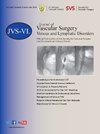Ultrasound-guided foam sclerotherapy of the saphenous trunks is associated with a low 5-year recurrence rate and improved quality of life in patients with chronic venous disease: A multicenter study
IF 2.8
2区 医学
Q2 PERIPHERAL VASCULAR DISEASE
Journal of vascular surgery. Venous and lymphatic disorders
Pub Date : 2025-02-19
DOI:10.1016/j.jvsv.2025.102212
引用次数: 0
Abstract
Objective
The study attempts to test whether ultrasound-guided foam sclerotherapy (UGFS) is a durable treatment for incompetent great saphenous vein (GSV) and incompetent small saphenous vein (SSV) in primary chronic venous disease (CVD), Clinical-Etiology-Anatomy-Pathophysiology (CEAP) clinical grade 2 to 4 disease. Secondary end points are to evaluate its safety in terms of complications, to compare patients' quality of life before and after the treatment, and to identify risk factors that may predict recurrence of CVD after UGFS.
Methods
Multicenter retrospective cohort study on 346 patients. The sclerosing agent was sodium tetradecyl sulfate (STS) in foam. The foam was prepared with the double-syringe technique (liquid-to-gas CO2O2 30:70 ratio of 1:4). The sclerosing agent concentrations were 1% for saphenous trunk diameter 4 to 7 mm, 3% for saphenous trunk of >7 mm. Sodium tetradecyl sulfate was injected directly into the GSV/SSV, achieving a total maximum volume of 10 mL per session. A median of two sessions was performed (range, 1-5).
Results
In this cohort, 205 patients were categorized as CEAP C2 (59.2%), and 141 (40.8%) had worse CVD (CEAP ≥3). The median follow-up was 60 months (range, 6-60 months). At the end of follow-up, 296 patients (85.5%) had no truncal reflux, with a 5-year disease-free time (between last procedure and evidence of recurrent disease) of 77.7 ± 2.16%. GSV and SSV showed similar 5-year recurrence-free time rates (69.9% vs 76.8%; P = ns), whereas patients with a diameter of the saphenous trunk of ≤8 mm had lower recurrence than those with >8 mm (91.3% vs 46%; P < .0001). Ninety patients (26%) showed CVD recurrence, occurring at a median of 48 months. A further UGFS treatment was needed in 50 symptomatic patients (14.4%), resulting in an 80% success rate. At univariate analysis, large diameter of the saphenous trunk (P < .0001), male sex (P = .030) and greater number of treatment sessions (P = .009) were identified as significant prognostic factors for recurrence. Immediate complications occurred in 3.7% of patients: seven headache and six visual disturbances. Endovenous foam-induced thrombosis was detected in six patients (2.8%) 1 week after treatment. Cutaneous hyperpigmentation appeared in 37 patients (10.7%). Post-treatment revised Venous Clinical Severity Score and Chronic Venous Disease Quality of Life Questionnaire 14 scores were significantly lower than before treatment (P < .001).
Conclusions
UGFS of the GSV/SSV is effective, safe in the long term and well-accepted by patients. UGFS is a viable option to surgery and endovenous thermal or nonthermal ablation in the treatment of saphenous trunk incompetence (CEAP clinical grade 2-4).
超声引导下隐静脉干泡沫硬化治疗与慢性静脉疾病患者5年复发率低和生活质量改善相关:一项多中心研究
目的:探讨超声引导泡沫硬化疗法(UGFS)对原发性慢性静脉疾病(CVD)、CEAP临床分级2-4级疾病中大隐静脉功能不全(GSV)和小隐静脉功能不全(SSV)的治疗效果是否持久。次要终点是在并发症方面评估其安全性,比较患者治疗前后的生活质量,并确定可能预测UGFS后CVD复发的危险因素。方法:对346例患者进行多中心回顾性队列研究。泡沫中的硬化剂为十四烷基硫酸钠(STS)。泡沫的制备采用双注射器技术(液气比1:4)。对于直径4 ~ 7mm的隐管,固化剂浓度为1%,对于直径0 ~ 7mm的隐管,固化剂浓度为3%。STS直接注射到GSV/SSV中,每次注射的总最大体积为10毫升。中位数为2个疗程(范围1-5)。结果:205例患者分为CEAP C2级(59.2%),141例(40.8%)CVD较差(CEAP≥3)。中位随访为60个月(范围6-60)。随访结束时,296例(85.5%)患者无肠段反流,5年无病时间(从最后一次手术到疾病复发证据)为77.7±2.16%。GSV和SSV的5年无复发率相似(69.9% vs. 76.8%, p ns),而隐干直径≤8mm的患者复发率低于大隐干直径≤8mm的患者(91.3% vs. 46%, p结论:GSV/SSV的UGFS是有效的,长期安全的,为患者所接受。UGFS是手术和静脉内热消融或非热消融治疗隐干不全的可行选择(CEAP临床分级2 - 4)。
本文章由计算机程序翻译,如有差异,请以英文原文为准。
求助全文
约1分钟内获得全文
求助全文
来源期刊

Journal of vascular surgery. Venous and lymphatic disorders
SURGERYPERIPHERAL VASCULAR DISEASE&n-PERIPHERAL VASCULAR DISEASE
CiteScore
6.30
自引率
18.80%
发文量
328
审稿时长
71 days
期刊介绍:
Journal of Vascular Surgery: Venous and Lymphatic Disorders is one of a series of specialist journals launched by the Journal of Vascular Surgery. It aims to be the premier international Journal of medical, endovascular and surgical management of venous and lymphatic disorders. It publishes high quality clinical, research, case reports, techniques, and practice manuscripts related to all aspects of venous and lymphatic disorders, including malformations and wound care, with an emphasis on the practicing clinician. The journal seeks to provide novel and timely information to vascular surgeons, interventionalists, phlebologists, wound care specialists, and allied health professionals who treat patients presenting with vascular and lymphatic disorders. As the official publication of The Society for Vascular Surgery and the American Venous Forum, the Journal will publish, after peer review, selected papers presented at the annual meeting of these organizations and affiliated vascular societies, as well as original articles from members and non-members.
 求助内容:
求助内容: 应助结果提醒方式:
应助结果提醒方式:


